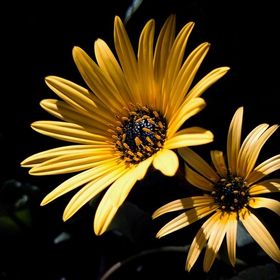

CharlB
Follow
Views
145
Likes
Peer Award
Top Choice
Superb Composition
Magnificent Capture
Outstanding Creativity
Top Ranks
Categories
Same photographer See allBehind The Lens
Discover more photos See all
Behind The Lens
Location
This photo was taken during late afternoon in Addo National Park, close to Port Elizabeth in South Africa.Time
We were driving back from a game drive to get to the campsite gates before it closes for the night. After many elephant sighting during the afternoon, I saw this lone elephant approximately 60 meters from the road, positioned in such a way that the low sun highlights it entire left hand side of the body. This photo was taken approximately at 17h00 and sunset would have been at about 18H00, that when the gates to the camp also closes.Lighting
I have done a number of elephant shots on this day and after downloading all the images, deleting the images I do not like, I decided to keep this one and thought I would be a bit creative with this ordinary and boring photo. The ambient light was a soft bronze, just enough to show up the detail of the elephant's skin.Equipment
I used my closest camera on hand which was the Sony SLT A55v, fitted with a Sigma 70-200mm F2.8 lens. No flash or tripod was used. Camera setting was ISO 1000.00, 1/130th of a second, F4, 160mm focal length.Inspiration
We have seen plenty elephants during day, all of them in herds between 20 and 80. On the way back to the camp, I was still scouting for the elusive lone bull elephant with huge tusks, but saw this lone docile elephant and wondered where its herd is. I stopped and started scouting the valley below, no signs of a herd. I decided to take a few photos because of the bronze sunlight on its skin.Editing
Yes, I did. I decided to mask the elephant and change the background to monochrome, also applied some blur. I decided to over sharpen the the elephant to obtain an exaggerated skin texture look and then applied shadow and highlights effect to obtain a bigger contrast. Last part was to saturate the skin colour to obtain a bronze look. This is now a living bronze ellie.In my camera bag
I pack my kit based on the expected needs. When I travel for wild life and general nature photography into wilderness areas, I like to travel light and keep my kit as simple as possible. Camera gear is the Sony A77ii and my brand new Sony A7iii. I have sold the Sony SLT A55V in the mean time. Lenses are the Sigma 70-200 F2.8 with 1/4 converter, Sony 16-50mm F2.8 and Tamron 28-75mm F2.8 macro. Manfrotto monopod. Proper cleaning kit. I found the Sigma 70-200mm lens is perfect for my purposes, easy to handle inside the Land Rover and not too heavy to carry on a walking safari. I have been fortunate and I guess patient enough to get close enough the lion, cheetah, leopard, elephant and even birds to get photos with the 70-200mm and 1/4 converter.Feedback
Photographing wild life can be very rewarding and at the same time very frustrating. There are quite a few factors you have to bear in mind over which you have no control. It is the weather, the terrain, animal behaviour and technical problems. Many visitors to game parks in Africa want to photograph the big five and are quite often disappointed because they did not find some of the animals due to lack of knowledge about the animal. Read up about the animal's behaviour, is it nocturnal, what terrain does it prefer etc. When I seek a specific animal to photograph, I focus for the first hour or two on the smaller things in the wild eg. animal tracks, lizards, insects, plants to get my senses tuned for the terrain I am in. Quite often the smaller animals and insects will provide clues eg. dung beetles indicates recent rhino and elephant activity. Pale chanting goshawks quite often will lead you to a honey badger, mice and rat activity will lead to cape cobra and puffadder sightings, springbok herds will lead you to leopard and cheetah, bigger game will often lead to lion, hyena and jackal sightings. I have experienced many rewarding experiences, tracking and searching for the target animal I want to photograph, which I never saw on that day because a found something else to photograph.











































